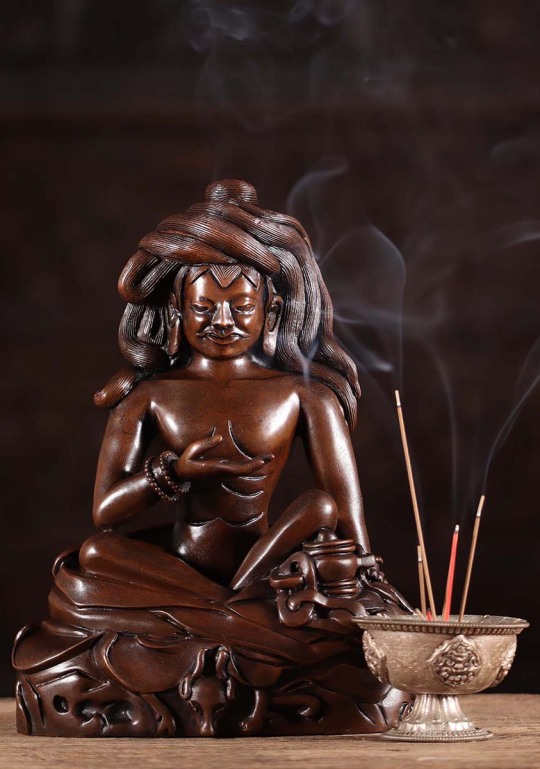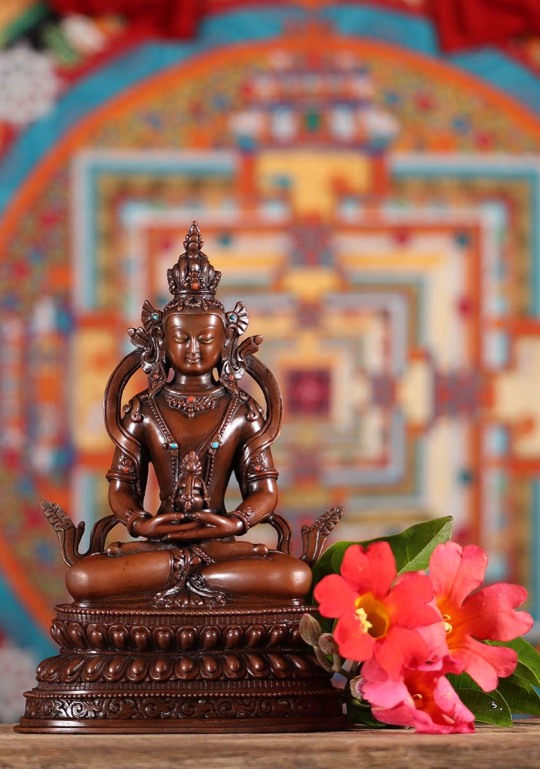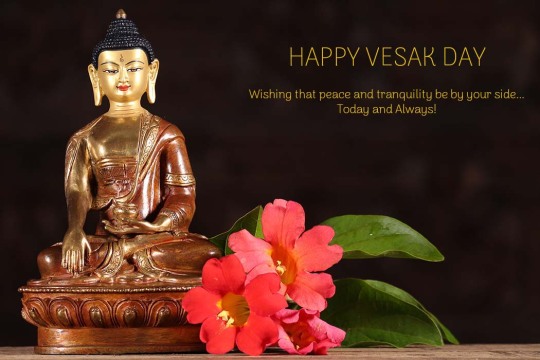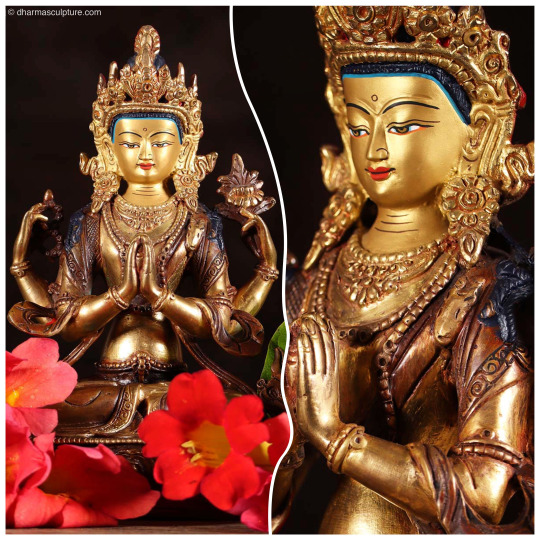Don't wanna be here? Send us removal request.
Text

http://www.dharmasculpture.com/
This Ratnasambhava Buddha is seated in varada mudra, his left hand is in the mudra of meditation. His legs are folded in dhyana asana and he is seated on a beautiful golden lotus throne. On the top part of the arch you will find a small figure of Amitabha Buddha, the most ancient Buddha among the Dhyani Buddhas. This beautiful work of art embodies the compassionate presence of Ratnasambhava, inspiring devotees to cultivate a spirit of generosity and gratitude in their lives. As practitioners contemplate the radiant form of Ratnasambhava, they are reminded of the inherent richness of the human spirit and the boundless potential for generosity to foster harmony and well-being in the world. This sculpture was hand crafted by the very talented artists of the beautiful Himalayan Kingdom of Nepal!
#dhyanibuddha#ratnasambhava#ratnasambhavabuddha#vedana#varadamudra#meditationbuddha#amitabhabuddha#goldenbuddha#nepaleseart#buddhistart#buddhism#buddha#dharmasculpture
1 note
·
View note
Text

http://www.dharmasculpture.com/
Thangtong Gyalpo (1361-1485 CE), or "The King of the Empty Plain," was a Buddhist Mahasiddha, a Chöd master, yogi, physician, blacksmith, architect, and pioneering civil engineer. In addition, he is believed to be the most widely traveled person in Tibetan history. He's also known by the names Chakzampa, the "Iron Bridge Builder," and Tsondru Zangpo, "Excellent Persistence." Many people believe he was an emanation of both Padmasambhava (known as "Guru Rinpoche" among Tibetan Buddhists) and Dolpopa Sherab Gyaltsen, the foremost master of shentong and a major proponent of the Jonang tradition. Aside from his architectural feats of building 58 iron chain suspension bridges (several of which are still in use today) and erecting several large stupas across Tibet and Bhutan, he is known for founding the Iron Chain lineage of the Shangpa Kagyu tradition. Furthermore, he is known for developing Lhamo or Tibetan theater in the 14th century and establishing song and dance troupes to raise money needed to build bridges. Performers would tell stories, recite mantras, and perform song and dance as a means to both teach and subdue demons for the sake of building Tangtong Gyalpo's bridges. Lastly, Tangtong Gyalpo was known for his ability to eradicate disease. His famous prayer commonly known as "Thangtong Gyalpo's Refuge Prayer" is said to be helpful for averting adverse circumstances and transforming difficulty.
This sculpture was hand crafted by the very talented artists of the beautiful Himalayan Kingdom of Nepal!
#Thangtong Gyalpo#gyalpo#mahasiddha#Chöd master#chakzampa#Tsondru Zangpo#iron bridge#padmasambhava#guru rinpoche#tibetanbuddhist#Dolpopa Sherab Gyaltsen#Jonang tradition#Shangpa Kagyu#lhamo#tibetantheater#nepaleseart#buddhistart#buddhism#dharmasculpture
1 note
·
View note
Text

http://www.dharmasculpture.com/category/new-arrivals.html
Apartmita (Amitayus) is seated on a double lotus pedestal with his hands in meditative gesture (dhyana mudra) holding his identifying attribute, the ambrosia vase. The vase is richly decorated and from the cover fall four strings of beads which represent sacred pills. Here the hand gesture, representing meditative equipoise, represents the unitiy of wisdom and compassion. As the Buddha of Infinite Life, he is invoked during rituals associated with the prolonging of life. Aparmita wears a crown and regal jewelry consisting of elaborate necklaces, large earrings inset with coral and turquoise stones, and a flowing scarf over his shoulders. His face expresses a state of meditation, with narrowed eyes and an inward gaze. A classic Buddhist representation.
This sculpture was hand crafted by the very talented artists of the beautiful Himalayan Kingdom of Nepal. http://www.dharmasculpture.com/
#aparmita#amitayus#lotusbase#lotusflower#ambrosia#meditation buddha#meditationpose#buddha#buddhism#buddhistart#nepaleseart#dharmasculpture
6 notes
·
View notes
Text

http://www.dharmasculpture.com/
This Newari style Green Tara statue radiates love and compassion. She is an exquisite piece of spiritual craftsmanship, hand-carved with incredible detail by skilled artisans from Patan, Nepal, this statue captures the serene compassion and protective energy of the Sacred Mother. Every detail, from Tara’s serene expression to the intricate patterns showcases the dedication of Nepalese artisans, creating a powerful symbol of peace, compassion and guidance for your sacred space. Green Tara is a prominent deity in Mahayana and Vajrayana Buddhism, symbolizing compassion and protection. According to Buddhist tradition, Green Tara arose from a tear of Avalokiteshvara, the Bodhisattva of compassion and vowed to assist all beings in overcoming fear and suffering. She is known for her ability to swiftly respond to the prayers of those in need, often invoked for protection from dangers and obstacles. Green Tara, Harit Tara, the Buddha of enlightened activity is Tara's most dynamic manifestation. She is considered the consort of Amoghasiddhi. Her mantra, "Om Tare Tuttare Ture Soha," is widely chanted to invoke her blessings and support.
#newariart#greentarastatue#greentara#sacredmother#peace#compassion#nepaleseart#mahayanabuddhism#vajrayanabuddhism#avalokiteshvara#bodhisattvaofcompassion#harittara#amoghassidhi#buddhism#buddhistart#dharmasculpture
3 notes
·
View notes
Text

http://www.dharmasculpture.com/
Today, Buddhists around the world will celebrate Vesak, also known as “Buddha Day.” The festival commemorates the birth, enlightenment, and death of the historical Buddha, Siddartha Gautama, born 2,600 years ago. These three key moments are all said to have occurred on the same day, many years apart. In places where Vesak is celebrated, devotees typically make offerings of flowers, candles, and burning incense. The life Vesak celebrates is not that of a god, but of a human being, just like the rest of us. Buddhists are reminded to live in harmony and explore who the Buddha really was. His life, His teachings, His humanity, and His path.
#vesak#vesakday#buddhism#buddhistteachings#buddha day#buddhabirthdayfestival#siddartha#siddarthagautama#shakyamunibuddha#threejewels#dharmasculpture
3 notes
·
View notes
Text

http://www.dharmasculpture.com/category/porcelain.html
Lord Buddha's face conveys a gentle inward expression. Through his knowledge of discriminative wisdom, a Bodhisattva understands the empty nature of all sentient beings and develops great compassion for them. This is the dhyana or meditation of Buddha Amitabha.
Lord Buddha's hand is in varada mudra. This mudra symbolizes charity, compassion and boon-granting. It is the gesture of the accomplishment of the wish to devote oneself to human salvation. The five extended fingers of this mudra symbolize the following five perfections: generosity, morality, patience, effort and meditative concentration.
Lord Buddha is seated in the padmasana or full lotus position atop a throne with devotees. Details abound.
http://www.dharmasculpture.com/category/new-arrivals.html
#porcelainbuddha#buddha statues#buddhastatue#buddha#gentlebuddha#buddhawisdom#bodhisattva#varadamudra#padmasana#buddhism#buddhistart#dharmasculpture
1 note
·
View note
Text

http://www.dharmasculpture.com/ This beautiful African coral wood Buddha statue is depicted in abhaya mudra also known as the gesture of protection. This is one of the most popular hand gestures of the Buddha which is said to transmit the energy of protection, peace and a sense of strong, deep inner security. This wood sculpture is a one of a kind statue, hand carved by the very talented artists of the beautiful Kingdom Cambodia. http://www.dharmasculpture.com/category/new-arrivals.html
#peacefulbuddha#woodenbuddhacarving#woodenbuddhastatue#woodenbuddha#protectionbuddha#abhayamudra#abhayamudrabuddhastatue#enlightenedbuddha#cambodianbuddha#cambodianbuddhastatues#khmerbuddhastatues#buddha statues#buddha#buddhism#buddhistart#dharmasculpture
3 notes
·
View notes
Text

http://www.dharmasculpture.com/
These standing Buddha statues are depicted holding alms bowls. In Buddhism, the begging bowl, or alms bowl, is one of the simplest but most important objects in the daily lives of Buddhist monks. It is primarily a practical object, used as a bowl in which to collect alms from lay supporters. The simple begging bowl, has, over time become a symbol of the Buddha's teachings of non-attachment.
http://www.dharmasculpture.com/category/new-arrivals.html
#woodenbuddhastatue#woodenbuddhacarving#buddha#buddhastatue#cambodianbuddha#khmerart#cambodianart#handcarvedbuddhastatue#handcarvedbuddha#buddhistalmsbowl#buddhistmonks#shakyamuni#shakyamunibuddha#buddhistgreatguardiankings#buddhistbeggingbowl#buddhism#khmerbuddhastatues#cambodianbuddhastatues#buddhistart#dharmasculpture
2 notes
·
View notes
Text

http://www.dharmasculpture.com/
This striking seated Cambodian Buddha features a captivating antique golden color.Lord Buddha sits gracefully in padmasana, full lotus pose. His right hand is in vitarka mudra, the gesture used when discussing the dharma with his disciples. A stunning centerpiece for any spiritual or meditative space.
This piece is one of kind, you will receive this exact Buddha statue with your order.
http://www.dharmasculpture.com/category/new-arrivals.html
#buddha#buddha statues#cambodianbuddha#cambodianbuddhastatues#woodenbuddhastatue#woodenbuddha#padmasana#vitarkamudrabuddha#vitarkamudra#dharma#dharmabuddha#khmerbuddhastatues#buddhism#buddhistart#handcarvedbuddhastatue#dharmasculpture
2 notes
·
View notes
Text

http://www.dharmasculpture.com/
Quan Yin (also spelled Kuan Yin, Kwan Yin or Guan Yin), is known as the Goddess of Compassion, and she is one of the most popular deities in all of Asia. Many believe that she is the female representation of Avalokiteshvara the Tibetan and Nepalese God of Compassion. As a Bodhisattva, she has chosen to put off her complete, unexcelled, perfect enlightenment for the benefit of beings everywhere, and will wait as long as there is one being who is not enlightened. This beautiful porcelain statue is depicted standing on the waves of the ocean. She holds a wish stick cradled in her left arm which grants wishes to her devotees. Her features are long and slender with a gentle smile. There is third eye, urna on her forehead with an Amitabha headdress. http://www.dharmasculpture.com/category/porcelain.html
#kuanyinstatue#kuanyin#quanyin#kwan yin#kwanyingoddess#kwanyinstatue#guanyin#guanyinstatue#goddessofcompassion#bodhisattva#bodhisattvaavalokiteshvara#porcelainkuanyin#buddhistart#buddhism#dharmasculpture
3 notes
·
View notes
Text

http://www.dharmasculpture.com/
This antique finish Buddha statue is seated in dhyana asana, the meditative pose also called padmasana. His hands are held in vitarka mudra, the Buddhist Wheel of the Law. Vitarka Mudra is the mudra or gesture representing the discussion and transmission of the teachings by the Buddha. It is also taken as the hand gesture which induces the energy of the teachings and discussions of the spiritual principles. This wood sculpture is a one of a kind statue, hand carved by the very talented artists of the Kingdom Cambodia.
http://www.dharmasculpture.com/category/wood-buddhas.html
#buddha#buddhastatue#buddhateachings#dhyana asana#padmasana#meditationpose#vitarkamudra#vitarkamudrabuddha#wheelofthelaw#wheelofthedharma#cambodianbuddhastatues#khmerart#buddhism#buddhistart#woodenbuddha#dharmasculpture
1 note
·
View note
Text

http://www.dharmasculpture.com/
Lord Buddha's face conveys a gentle inward expression. Through his knowledge of discriminative wisdom, a Bodhisattva understands the empty nature of all sentient beings and develops great compassion for them. This is the dhyana or meditation of Buddha Amitabha.The whole of the right hand is cradled by the left with an alms bowl resting in his palms. Here the hand gesture, representing meditative equipoise, represents the unity of wisdom and compassion. Lord Buddha is seated in the padmasana or full lotus position atop a throne with a three-tiered lotus flower base.
http://www.dharmasculpture.com/category/new-arrivals.html
#porcelainbuddha#buddhastatue#gentlebuddha#buddhawisdom#bhodisattva#sentient beings#dhyanamudra#dhyanamudrabuddha#meditationbuddha#buddhaamitabha#buddhistalmsbowl#padmasana#lotusflower#buddhism#buddhistart#dharmasculpture
1 note
·
View note
Text

http://www.dharmasculpture.com/
Angkor King Jayavarman VII is depicted with his hair tied in a bun, engaged in deep meditation. Closed eyes, a smile illuminating his face: the serene expression of King Jayavarman evokes compassion. This is the face of a king who felt that the sufferings of his people were his own suffering and who built an extensive network of hospitals to take care of his people. A fervent Mahayana Buddhist, he placed Buddha and Lokeshvara at the top of a pantheon in which Hindu gods were also largely represented. He was king of the Khmer Empire in present day Siem Reap, the capital city of Siem Reap Province in northwestern Cambodia. It is the gateway to the Angkor region.
http://www.dharmasculpture.com/category/cambodian-buddha-statues.html
#angkorking#angkorkingjayavarman#kingjayavarman#kingjayavarmanvii#sereneexpression#buddhism#mahayanabuddhism#khmerempire#angkorregion#khmer art#cambodianart#buddhistart#dharmasculpture
2 notes
·
View notes
Text

http://www.dharmasculpture.com/
Shadakshari Lokeshvara is a four-armed variant of the Bodhisattva Avalokiteshvara, who holds his inner hands to his chest in anjali mudra, the gesture of adoration. Kharchheri is a form of Bodhisattva Avalokiteshvara. Om Mani Padme Hum is the famous mantra of Chenrezig in Tibetan. It is said that all the teachings of the Buddha are contained in this mantra. Tibetan Buddhists believe that saying the mantra (prayer), out loud or silently to oneself, invokes his powerful benevolent attention. Viewing the written form of the mantra is said to have the same effect, and it is often carved into stones, placed where people can see them. Lokeshvara is always decked with all sorts of ornaments. He is four armed carrying malas in his right hand and a full blown lotus in his left. The other two principal hands are raised to the chest with the palms joined in Namaskar Mudra with a round object known as "The Jewel" a symbol of knowledge held in the center.
In the Tibetan Buddhist pantheon of enlightened beings, Chenrezig is renowned as the embodiment of the compassion of all the Buddhas, the Bodhisattva of Compassion. Avalokiteshvara is the earthly manifestation of the self born, eternal Buddha, Amitabha. He guards this world in the interval between the historical Sakyamuni Buddha, and the next Buddha of the future, Maitreya. Chenrezig may be the most popular of all Buddhist deities, except for Buddha himself, he is beloved throughout the Buddhist world. He is known by different names in different lands: as Avalokiteshvara in the ancient Sanskrit language of India, as Kuan Yin in China, as Kannon in Japan and Chenrezig to Tibetans.
http://www.dharmasculpture.com/category/tibetan-nepali-statues.html
#tibetanchenrezig#chenrezigstatue#shadaksharilokeshvara#bodhisattvaavalokiteshvara#amitabha#anjalimudra#namaskarmudra#namaste#kannonstatue#lokeshvarastatue#gestureofadoration#copperbuddha#nepalesebuddha#nepalesebuddhistart#buddhism#buddhistart#dharmasculpture
1 note
·
View note
Text

http://www.dharmasculpture.com/
Lord Buddha wears a monk’s robe, the border of which falls over his left arm. He has a peaceful countenance with downcast introspective eyes. His earlobes are stretched long from a youth spent as a prince wearing heavy gold earrings. Lord Buddha is seated on a throne decorated with a single row of lotus flowers on the front of the base. The fingers of his right hand are slightly touching the ground, this hand gesture, also known as bhumisparsha mudra represents the subduing of Mara (a demon) who attacked Buddha with violent storms and three seductive daughters. Remaining steadfast, the Buddha testified to his meritorious past by pointing to the earth and calling the Earth Goddess as witness. Rising from the ground the Earth Goddess wrings the water from her long black hair. By doing so, she raises a torrential flood that drowns Mara and his army of demons. The earth touching gesture reflects this story symbolizing enlightenment, as well as steadfastness and the Buddha’s achievement of nirvana. The peaceful countenance of Lord Buddha exudes harmony. The perfect Buddha statue to bring serenity to your home, office or sacred space! This one of a kind statue was hand made by a very talented artist in the beautiful country of Myanmar (Burma). Every piece is truly unique! http://www.dharmasculpture.com/category/burmese-buddha-statues.html
#buddha#lordbuddha#peacefulbuddha#buddhistlotusflower#bhumisparshamudra#earthtouchingbuddhastatue#antiquebuddhastatue#bronzebuddhastatue#burmesebuddhastatue#mandalaybuddhastatue#buddhism#buddhistart#dharmasculpture
2 notes
·
View notes
Text

http://www.dharmasculpture.com/
This beautiful pink speckled contemporary Cambodian Buddha statue was recently carved from an antique piece of wood. Lord Buddha has a wonderful serene expression and a faint smile. He is depicted in vitarka mudra. Vitarka mudra is one of the most commonly found mudras or poses. Vitarka Mudra is the mudra or gesture representing the discussion and transmission of Lord Buddha's teachings.
The ushnisha, protuberance above his head also referred to as a topknot, symbolizes His wisdom and openness as an enlightened being. He has elongated earlobes, a vestige of his life as a prince, when he wore extravagant jewelry.
The art of Cambodian wood sculpture goes back to the glorious epoch of the Khmer empire and the monumental constructions that gave rise to the Angkor temples. Our artisans have inherited patience and meticulousness from their ancestors in the trade. They have learned to capture the movements used in olden times and have mastered the use of traditional tools in order adapt to their personal lines of work.
This wood sculpture is a one of a kind statue, hand carved by the very talented artists of the beautiful Kingdom of Cambodia!
http://www.dharmasculpture.com/category/new-arrivals.html
#cambodianbuddha#pinkbuddha#vitarkamudrabuddha#vitarkamudra#buddhasteachings#ushnisha#buddhaswisdom#khmerbuddhastatues#khmer art#cambodianart#woodenbuddhastatue#buddhistart#buddhism#dharmasculpture
2 notes
·
View notes
Text

http://www.dharmasculpture.com/
Dvarapalas (temple lions) traditionally stand guard outside the gates of shrines, Buddhist temples and porticos of homes. In Japan, they are referred to as Shishi (or Jishi) and can also refer to a deer or dog with magical properties and the power to repel evil spirits. In China they are referred to as Foo Dogs and are traditionally depicted in pairs. In Thailand they are referred to as Singha, the true king of the forest. His roar echoes to great distances, terrifying all forest animals, great and small, and stand at the entrance of Thai temples, guarding the sacred Buddhist teachings. In Indonesia and Cambodia they are referred to as 'Dvarapalas' and are generally armed with lances and clubs and can often times have a bulky physique. The main function of Dvarapalas is to protect the temples. Dvarapalas in Cambodia may be seen, for example, at various temples in and around Angkor Wat.
This wood sculpture is a one of a kind statue, hand carved by the very talented artists of the beautiful Kingdom of Cambodia. http://www.dharmasculpture.com/category/new-arrivals.html
#dvarapala#dvarapalas#dvarapalacarving#dvarapalaprotection#buddhisttempleguardian#templelion#jishi#angkorguardian#cambodianart#khmer art#buddhistart#woodentempleguardian#buddhismprotector#dharmasculpture
1 note
·
View note